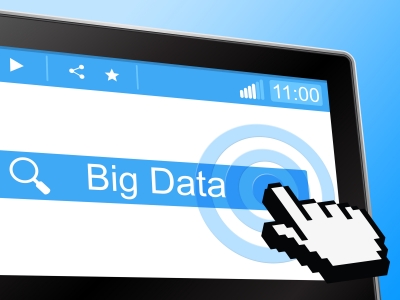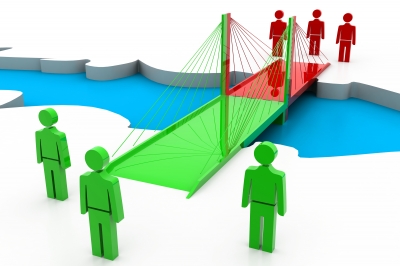Can Big Data Bridge the Gap between Sales and Marketing?
Morris George, PhD

With the advancement in storage technology and the rise of Internet and social media, more and more information is becoming readily available to both customers and agencies. Today, customers are able to get almost all the information they need to make a purchase decision through websites both of the focal company and their competitors, feedback and ratings of other customers and users, through blogs, online product reviews and social media. At the same time, agencies can collect a wealth of information about their customers through their prior purchases, their interests and opinions as revealed through social media postings, blogs, etc. in addition to other information generally available through traditional channels such as demographics and psychographics. This vast amount of structured and unstructured customer data available to agencies is commonly referred to as “big data.” Big data is generally characterized by high volume, high velocity, and high variety. There is increasing pressure on companies to collect, analyze and use big data for better decision-making. When trying to market commercial and residential real estate, does the use of big data really result in better outcome measures for an organization?
It Pays to Make Use of Big Data
First, the use of big data can directly impact the performance of agencies, especially in terms of affecting their bottom line. Since big data allows businesses to target each account they have with the right message at the right time, it can reap rich dividends. For example, a McKinsey study shows that a data-centered approach to marketing and sales decisions helped companies to improve their marketing return on investment (MROI) by 15-20 percent (McKinsey Chief Marketing & Sales Officer Forum, 2013). Along the same lines, a business outsourcing company testifies that they could identify 52% more sales opportunities and increase sales productivity by 29% as a result of using big data tools (SmartData collective, 2014). In addition to the monetary benefits of using big data, firms can enjoy other benefits such as better equipping its sales and marketing professionals through big data’s role in bridging the gap between the two functions. Before we address how big data can facilitate bridging the gap between sales and marketing, we need to understand how the two are related and what separates them.
Current State of Relationship between Marketing and Sales
Functionally, the work of marketing and sales are deeply interconnected. And, the sales and marketing interface has a direct and significant impact on clients. Hence, it is imperative that these functions work together well to achieve better corporate performance (Dawes and Massey, 2005). Carpenter (1992) and Martin and Powers (1989) stressed the importance of a collaborative and productive relationship between sales and marketing. Kotler, Rackham, and Krishnaswamy (2006) cite examples where companies experienced substantial improvement in performance when sales and marketing worked together. In fact, Aberdeen Research finds that companies that tried to improve the relationship between these two functions and are "best-in-class" at aligning marketing and sales have a 20% average growth in annual revenue (PR Newswire, 2014). Unfortunately, the reality for many companies is a lack of cohesion, co-ordination, even distrust and negative stereotyping exist between sales and marketing (Anderson 1996).
Understanding the Reasons for the Gap and Addressing it
Part of the reason why there is a lack of cohesion is because of inherent differences between the people in each of these functions. In a 2011 article in Marketing Week, Cooper (2011) highlights how sales people differ from marketing and how their strategies and objectives also vary. One of the main reasons for a not-so-smooth relationship between marketing and sales is the lack of alignment in terms of objectives, strategy, and activities. According to a study by Eloqua, only 48% of marketing and sales teams share objectives. In addressing marketing-sales intergroup relations, Dewsnap and Jobber (2002) proposed that goal conflict and strength of a person’s affiliation to his/her marketing/sales groups lead to intergroup differentiation. The Realistic Group Conflict Theory suggest that conflicting goals lead to intergroup differentiation and that intergroup differentiation can be reduced when there are mutually desired superordinate goals, attainable only through intergroup cooperation (Jackson 1993).
One can conclude that the intergroup differentiation between sales and marketing should be less if there are mutually desired goals which can be achieved through cooperation. Following this logic, some companies have tried to integrate sales and marketing functions by coming up with shared goals. Among many suggestions to improve the relationship between marketing and sales such as giving them shared targets, strategy alignment and constant communication, Cooper (2011) also highlights the need for paving the way for transfer of knowledge and skills. One key thing to remember here is that mutual sharing must take place. Otherwise, strategies such as giving sales and marketing teams shared targets, or creating a structure for constant communication have the danger of being seen as directives coming from top management and tend to have less acceptance by either teams.
Big Data Calls for Changes in the Way We Do Business
This is where big data plays a crucial role. It calls for a change in the way we do sales calls and market our products. With the increased availability of information through the Internet, the balance of power seems to have shifted in favor of customers. Traditionally, salespeople possessed a lot of information regarding a product or service to which customers had no access. Until a few years ago, much of the information about the housing market such as MLS listings, current house prices in an area, and price movement were only available to the real estate agent or broker. Now, buyers can see the property listings along with very detailed information on its features and even take a virtual tour while also in many cases having access to the rating of realtors by other home buyers/sellers. This vast amount of data that constantly change and are available to customers often puts the salesperson at a disadvantage. In order to be effective in this changed business environment, sales people have to gain a much better understanding of their customers, market, and competitors. In other words, they have to increasingly make use of big data for achieving their objectives.
Big Data Creates Mutual Dependence and Shared Goals

Even though it contains the required information, the challenge is to make use of this big data and glean valuable nuggets of information without having to spend a lot of time and resources. Many sales people find this task to be very daunting as revealed by a survey, where 82% of sales people said they are challenged by big data. Marketing people, who are responsible for analyzing data on the other hand, need access to information that the sales team possesses. While marketing and marketing analytics teams can provide valuable information to the sales team, salespeople can in turn pass on a great deal of data to marketing including interactions with customers, intelligence from the field, and even competitors’ activity, to help them in the analysis of data. Thus, this calls for increased reliance on each other. Such mutual dependence between sales and marketing offers a great incentive for these functions to work together to achieve the superordinate goals. Sales people will be more willing to cooperate with marketing if marketing with the help of data and analytics, can provide them with better leads and better marketing tools that can help them close more business deals.
Big Data May Be Able to Change the Culture
Although it is a fact that a big data environment encourages sales and marketing to work together, it cannot usually happen without a change in the organizational culture. This is where organizations need champions of change. The change movement can be initiated by highlighting the benefits of stronger alliance between sales and marketing. One cannot emphasize enough the importance of communication between marketing and sales in improving their relationship. Big data offers a genuine opportunity for increased dialogue between sales and marketing. For example, marketing can seek feedback from sales on the quality of the leads generated through analytics, the effectiveness of messages, and the usefulness of other marketing tools. The two entities working together can develop more complete pictures of the agencies’ customers which can translate into more relevant promotional messages.
Conclusion
As evident from the above discussion, big data offers the opportunity not only to improve the performance of the agencies but also to bridge the gap between sales and marketing. It is up to the marketing and sales leaders to seize this opportunity. As keepers of big data, marketing should take the initiative to bridge the gap with sales by sharing information that sales professionals value and providing sales reps with better leads and effective tools that help them achieve more sales. Once sales realizes the value of big data and how data-based solutions that marketing provides impact their performance, they will be happy to cooperate with marketing. One thing is clear - big data is here to stay and is going to increasingly dictate the performance of sales and marketing teams. The question is, will companies make use of the opportunity presented by big data to bridge the gap between their sales and marketing functions? Only time will tell!
. . . . . . . . . . . . . . . . . . .
References
Anderson, Rolph E. (1996), "Personal Selling & Sales Management in the New Millennium," Journal of Personal Selling & Sales Management, 16(4), 17-32.
Carpenter, Philip (1992), “Bridging the Gap between Marketing & Sales,” Sales & Marketing Management, March, 29-31.
Cooper, Lou (2011), “Brand Guardians Can Bridge Great Divide,” Marketing Week, Jun 2, 22-3.
Dawes, Philip L. & G.R. Massey (2005), "Antecedents of Conflict in Marketing's Cross-functional Relationship with Sales," European Journal of Marketing, 14 (11/12), 1327-44.
Dewsnap, Belinda & David Jobber (2002), “A Social Psychological Model of Relations between Marketing & Sales,” European Journal of Marketing, 36(7/8), 874-94.
Kotler, Philip, Neil Rackham, & S. Krishnaswamy (2006), “Ending the War Between Sales & Marketing,” Harvard Business Review, July-August, 1-14.
Jackson, Jay W. (1993), “Realistic Group Conflict Theory: A Review & Evaluation of the Theoretical & Empirical Literature,” The Psychological Record, 43, 395-414.
Martin, William S. & Thomas L. Powers (1989), “Communication between Sales & Product Management: A Chance for Improvement,’’ Journal of Personal Selling & Sales Management, 66.
McKinsey Chief Marketing & Sales Officer Forum (2013), Big Data, Analytics, & the Future of Marketing & Sales.
PR Newswire (2014), “Bridging the Gaps Between Marketing and Sales,” https://www.prnewswire.com/news-releases/bridging-the-gaps-between-marketing-and-sales-257415081.html.
Smart Data Collective (2014), “How Big Data Can Help the Sales Team,” https://smartdatacollective.com/mike20/223246/how-big-data-can-help-sales-team.
. . . . . . . . . . . . . . . . . . .
About the Author
Morris George, PhD
Associate Professor of Marketing, Baylor University
Morris George (Ph.D. – University of Connecticut) is an Associate Professor of Marketing at Baylor University. His research interests include Customer Lifetime Value based customer contact strategies, cross-buying, multi-category catalog mailing, customer loyalty and profitability. He uses statistical and econometric modeling approaches and data analysis techniques to address issues facing marketers and policy makers in various fields including retailing, professional sports, corporate wellness, and non-profits. He has published in various marketing journals including Journal of the Academy of Marketing Science, Journal of Retailing, Journal of Service Research, and Health Marketing Quarterly. He is the recipient of the 2010 Davidson Award for his work on cross-buying published in the Journal of Retailing, while his research on customer equity won the JAMS/Sheth Foundation award for the best paper in the Journal of the Academy of Marketing Science in 2007. He received his MBA from Indian Institute of Management, Ahmadabad. Before entering academia, Morris worked for nearly 7 years in sales and marketing positions for a Fortune 500 petroleum company.